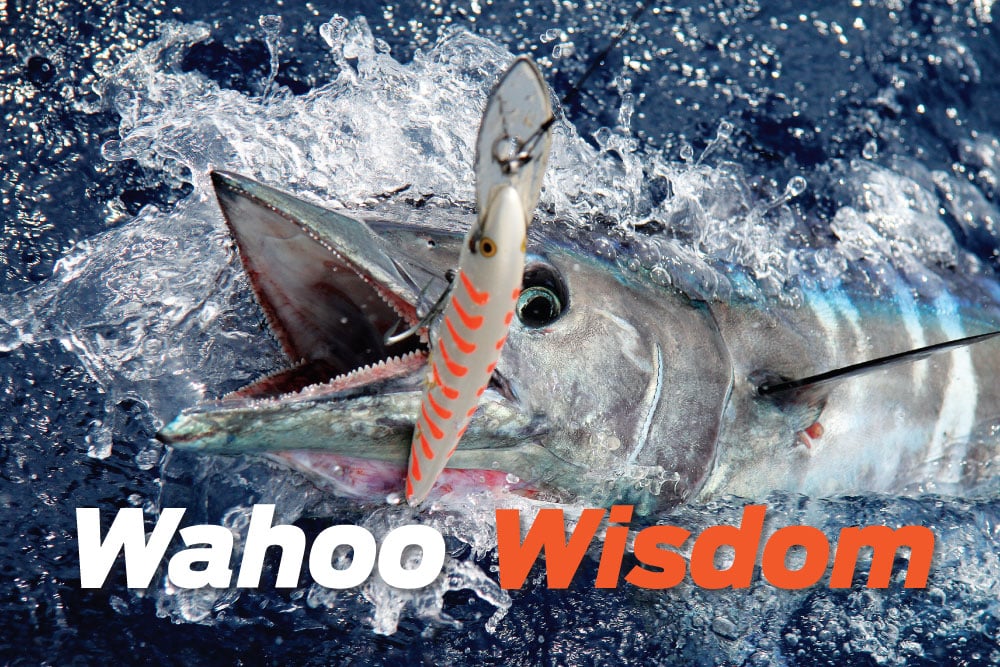
Wahoo! It’s simultaneously a fish species and an exclamation derived from their blistering speed. “Beyond question, the best part of wahoo fishing is hearing that reel scream,” says Ryan Grotta, owner of G-Fly Lures in Boca Raton, Florida. “There’s not much else that can pull line off the reel like a big wahoo,” adds Capt. George McElveen, owner of Reel McCoy out of Bud N’ Mary’s Marina in Islamorada, Florida.
Wahoo (also called ono) can swim at least 60 mph, so trolling at 14, 16 and even 20 knots is now commonplace using techniques developed by Capt. Ron Schatman, winner of a dozen major Bahamas wahoo tournaments over five years.
“In 1995, I went from pulling baits at 14 knots to pulling lures at 18 knots,” Schatman says. “From there, it all fell into place.”
High-speed trolling is certainly an effective way to catch wahoo, but so is slow trolling dead bait or lures, trolling live bait, dropping jigs or trolling beneath floating debris, chunking and even kite fishing. Nine wahoo fishing experts weigh in with their tips and techniques to catch these big, fast fish.
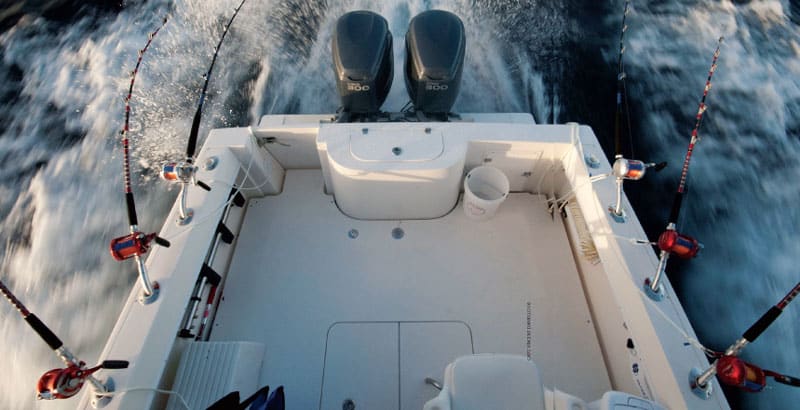
No. 1: How to High Speed Troll for Wahoo
Capt. Triston Hunt learned the basics of high-speed trolling directly from the master, Schatman. Hunt has since cultivated his high-speed wahoo setup into pure wahoo science, trolling a six-lure spread even from small boats, and winding up on the leaderboard in quite a few wahoo tournaments aboard his usual ride, Timeless, a 61 Viking, out of Boca Raton, Florida.
“The ideal speed is around 15 knots,” Hunt says. “There’s never any point to going slower. If I’ve got southeast wind, a steady barometer and clear water, and I’m not getting bites, I speed up to cover more ground or pick up and move because they’re biting somewhere.”
Hunt has consistently hooked wahoo trolling as fast as 22 knots, but if he hooks up or marks fish that don’t bite, he’ll go back through at his favorite 14- to 16-knot troll.
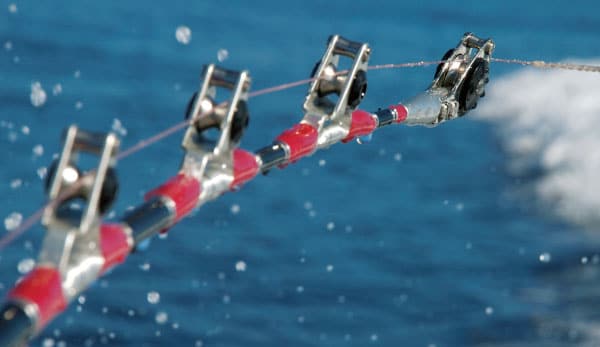
No. 2: Troll Six Lures for Wahoo
Hunt’s six-lure spread is key. “I’ve got my best wahoo lures out 150, 250 and 350 feet on the port side, and 200, 300 and 450 feet on starboard,” he says. Hunt makes abrupt 15-degree course changes to slide up and down a drop-off, staying between 120 and 350 feet of water. “The farther the bait is out, the more it slows and sinks on those turns, and then it speeds up again when I straighten out,” he says. “Those six lures are all covering different parts of the edge at different speeds and depths.”
To troll for wahoo beneath the waves — wahoo typically bite below the surface — Hunt uses 100-pound mono atop Spectra on 50-wide reels with drags set to 30 pounds. His wahoo trolling lures are rigged on four feet of No. 19 piano wire attached to a 25-foot 400-pound monofilament shock cord. A cabled trolling lead links the shock cord to his main line — generally 48-ounce leads on the shorts, 32-ounce leads on the mids, a 24-ounce lead on the 350-foot line and a 16-ounce lead on the 450-footer.
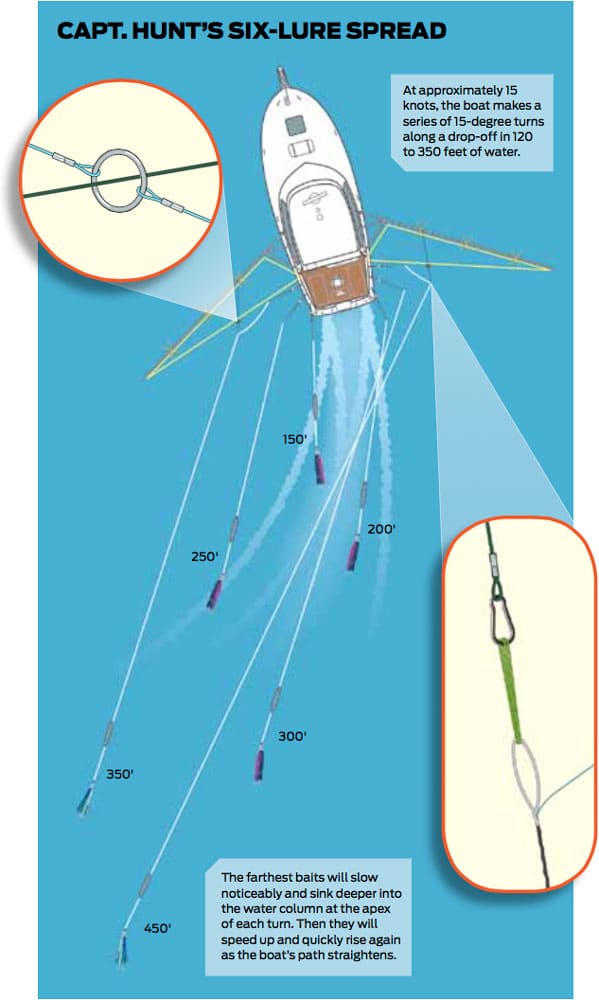
No. 3: How to React to a Wahoo Strike
First in the water, the long lines are let out to 450 feet and 350 feet, where Hunt has pre-rigged a 130-pound Dacron handcuff at each rod’s designated length. These attach with a doubled loop of 15-pound monofilament to a tag line run from the outrigger.
Next, the mids are let out to preset waxed flax markings at 300 feet and 250 feet, and trolled from the rod tips. Finally, the shorts go out to 200 feet and 150 feet, where Dacron handcuffs attached to short tag lines run from the engine exhaust tubes.
When a fish strikes, “clear everything shorter than the hooked fish on that side of the boat,” Hunt says. “Leave the other side out.” So if just a short lure is bitten, Hunt clears nothing. If the port mid hooks up, he clears the port short only. If a long line goes off, he clears the two shorter lines on that side.
“It’s always best to turn toward the fish to keep it clear of the other lines,” Hunt says. But if he is on his “uphill” leg — heading from deep water to shallow — and a fish bites a lure on the shallow side of his spread, Hunt won’t turn. “You don’t want to drag that fish into 60 feet of water,” he says.
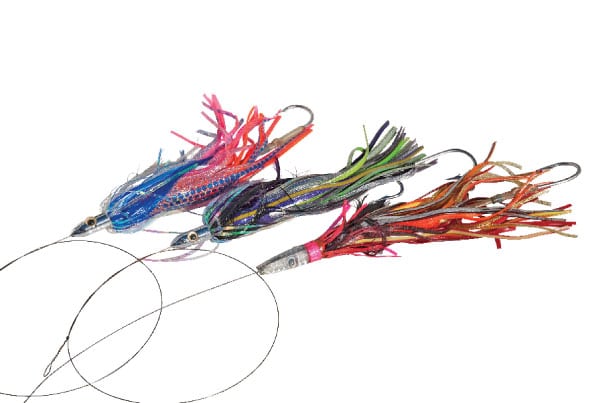
No. 4: Use Colorful Wahoo Trolling Lures
On one of Hunt’s best days — 26 fish with five weighing more than 80 pounds — all the bites came on green-and-blue wahoo trolling lures. On another day, he caught 27 fish all on pink-and-yellow. “I mix it up,” Hunt says. “Some big lures, some small, bright colors and dark, a jet head and a flat head. If I find something works particularly well, I’ll switch half of my spread to match, but I always leave three of something different.”
Hunt always has a few Yo-Zuri Bonitas aboard. While these large lures sometimes twist hooks out of fish, he’s seen days where they’re the only lures that work, trolled from his two short lines. On days when he can’t seem to catch a break, Hunt pulls out his special wahoo lure bag “with the most obnoxious, crazy color combinations you’ve ever seen,” he says. “Maybe it’s more mental, to give me confidence in my spread again. When I’m second-guessing what I have in the water, I never seem to catch as many fish.”
No. 5: You Don’t Have to Troll Fast for Wahoo
“I’ve caught a lot of wahoo at 9 or 10 knots, and I’ve got a much better chance of catching dolphin, tuna and billfish,” says Capt. Billy Black, who runs the charter boat El Viejo out of the Bimini Big Game Club, a Guy Harvey Outpost Resort and Marina in Bimini, Bahamas.
Black puts four lure-and-bait combinations out on the surface, and then sets two lines deep right off the transom for wahoo. “I like wahoo belly strips on my wahoo rigs. They’re tough and last a long time,” Black says. He rigs these behind a Billy Black series lure from Bob Schneider Lures using a pair of 10/0 double-strength J hooks and about a foot of No. 12 wire. Twenty-eight feet of 300-pound mono connects the lure to a 24- or 32-ounce trolling lead, which is connected to his main line.
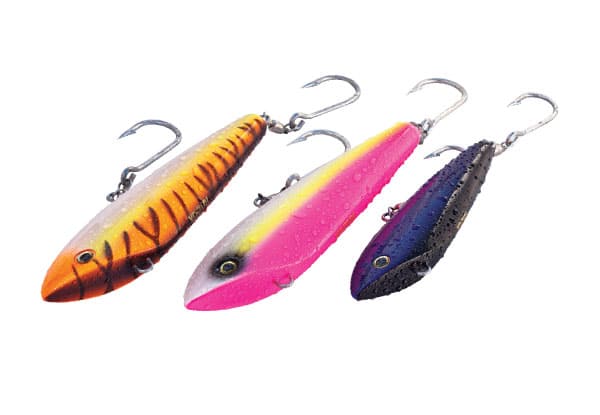
No. 6: Pull Wahoo Lures While Looking for Other Species
Capt. Ray Rosher of Miss Britt Charters in Miami falls between Hunt and Black, trolling artificial lures, not bait, at 8 to 10 knots. In the winter months, Rosher anticipates catching wahoo when he finds a clean-water edge anywhere between 200 and 400 feet deep.
Even when far offshore sight-fishing for dolphin, Rosher often pulls three of his own Wahoo Magnets while searching, and gets both wahoo and dolphin bites. “Having those lures out attracts fish,” he says. “They jitter along the surface and then go under for a while. Dolphin will eat them and wahoo won’t bite through the cable.”
Rosher staggers two small- or medium-size lures fairly far behind the boat off his outriggers, using only the lead in the head of the lure to keep them underwater. “Five- or 10-pound dolphin will come up on a medium-size lure but won’t eat it,” he says. “We often pick them up with the small lure about 250 feet behind the boat as a shotgun.”
No. 7: Take Chances With Your Wahoo Fishing Tackle
“Off Oregon Inlet, if I get three wahoo bites in a day, I’d call that a crazy wahoo bite,” says Mike Merritt, a freelance captain in North Carolina. “If I put wire out, dolphin will eat it, but the tuna won’t.” Instead, he often takes his chances with monofilament. “I hope it hooks in the corner of the jaw so it won’t bite through the mono.
“Wahoo are a structure-oriented fish. If I’m fishing a ledge or a wreck and there are a few around, I might put a bait behind an Ilander on wire,” Merritt says, typically on a planer to get it a few feet underwater. “Wahoo like a gaudy bait,” he says, so he picks his lure accordingly.
No. 8: Be on the Lookout for Wahoo all the Time
Wahoo range anywhere the water is warm — as far north as New York. Off Destin, Florida, Capt. Gary Jarvis trolls diving lures along weed lines. He targets wahoo on natural peaks or wrecks, or beneath debris offshore. “Live bait on downriggers works well,” Jarvis says. “Herring, Spanish sardines, blue runners — I put them down between 90 and 120 feet, and just bump an engine in and out of gear.”
Fishing from Port Aransas, Texas, Capt. Scott McCune finds his best wahoo fishing on wrecks, oil rigs, weed lines and debris by trolling ballyhoo at 5 to 8 knots behind Ilanders on the surface, and setting a couple of diving lures deep. “Bigger isn’t necessarily better,” McCune says. “If things are slow on the surface, sometimes a 4- or 5-inch Rapala gets attention deep and gets all the fish fired up, not just wahoo.”
Based in San Diego, Capt. Barry Brightenburg catches wahoo south of the border in Cabo San Lucas and Magdalena Bay by slow-trolling diving lures by Yo-Zuri, Rapala and the like. “If a big long-range boat just came through or an area has been pressured by private boats, I’ll use smaller lures and lighter wire for wahoo,” Brightenburg says.
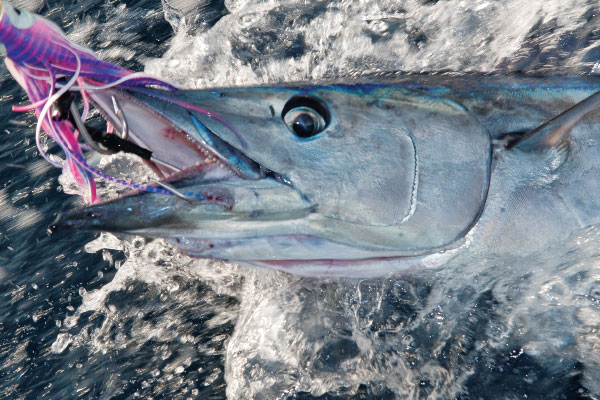
No. 9: Jig Beneath Debris for Wahoo
Fishermen know to check floating debris for dolphin, but most leave wahoo 60 feet beneath. Hunt is most successful when he marks wahoo — often 50 feet or more away from the debris, but he says, “If you’re catching dolphin, or if you see any life — tripletails, triggerfish or even a lot of bait — go ahead and drop down.” A fast-retrieve reel is essential: 6-to-1 or faster. Hunt drops a 4- to 6-ounce diamond jig rigged with a double-strength Mustad 3407 hook when he jigs for wahoo. The length of the jig helps protect his 60-pound fluorocarbon leader from teeth. He shies away from Butterfly-style jigs — with assist hooks at the top, he’s bitten off more often. “Let it down until you can’t stand it, 500 feet or more, and then reel it in as fast as you can.” The bite comes on either the drop or the retrieve.
McElveen also catches wahoo beneath debris, but he finds trolling a couple of diving plugs or No. 3 spoons easier for his often inexperienced charter guests. “Troll the spoon on a planer about 50 feet down, around 8 or 9 knots,” McElveen says. He uses 50 feet of 80-pound monofilament between the planer and the spoon. “A snap swivel at the spoon helps keep wahoo from biting off, and also prevents the line from twisting as the spoon spins.”
No. 10: Cut up Natural Baits and Chum for Wahoo
“When we’re kite-fishing for sailfish, wahoo will swim right up to the back of the boat,” McElveen says. Sometimes — though not often — they’ll eat typical Keys sailfish fishing baits like goggle eyes, pilchards and threadfin herring, but “wahoo usually go for the chunks over anything,” he says.
McElveen prefers speedo (redtail scad) cross-sections cut about an inch wide for his wahoo baits. “They look more natural than pieces of bonito,” he says, “like something that’s been bitten in half, not just a chunk of meat.” He stuffs a No. 2 treble hook into the side of a chunk, so it’s completely hidden yet pulls out easily. “You want the bait to come right off the hook when they eat,” he says. “You’ll get a lot more hookups.”
He throws three chunks in the water together and then immediately tosses the hooked bait atop. “Wahoo get a taste of those first three chunks and have to eat the fourth,” he says, making them less leery of the short piece of No. 3 wire and 40-pound monofilament leader.
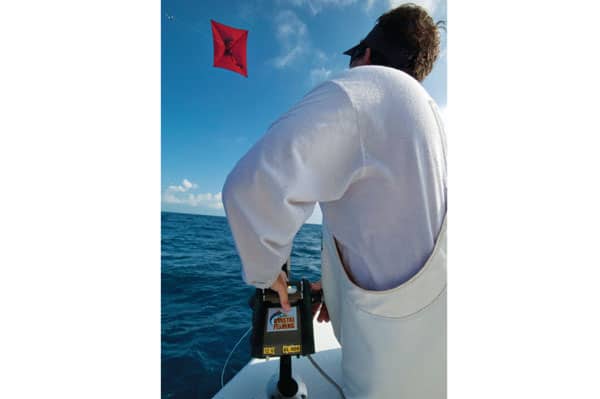
No. 11: Fish With Live Speedos on the Kite for Wahoo
When wahoo are mixed with kingfish, McElveen entices big fish to bite live speedo kite baits. “The speedos zip all over the place,” McElveen says. “If they see something, they go crazy, which really seems to trigger the wahoo and big kingfish to bite.”
McElveen prefers to anchor atop a wreck or prominent reef outcropping between 130 and 200 feet deep. He says a pair of three-foot lengths of No. 3 wire twisted together is harder for wahoo to bite through than a single heavier strand. This attaches to 10 feet of 40-pound monofilament as a leader. He bridles a 5/0 live bait hook through a speedo’s back when he can anchor or bridles the baits in the nose when he can’t. Another short length of doubled wire leads to a 2/0 treble‑hook stinger, hooked behind the dorsal.
With one speedo each on two kites held near the surface and far from the boat, McElveen works close in with speedo chunks and live pilchards hooked in the belly to make them swim down. “Be patient,” McElveen says. “Let all those chunks and pilchards do their thing. You might sit for an hour or more without much action, but then they school up, and it’s game on.”
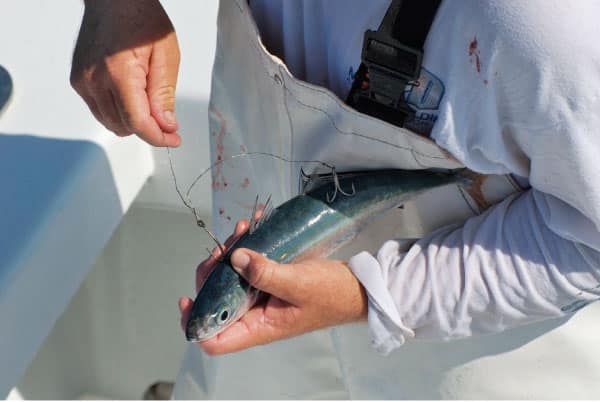
No. 12: Slow-Troll a Live Little Tunny for Wahoo
Often, when little tunny (commonly called “bonito” in Florida) are plentiful, so too are wahoo. Jeffrey Walls, manager at RJ Boyle Studios in Hillsboro, Florida, trolls atop wrecks to catch small “bullet” bonito, and then immediately bridles those as bait and slow-trolls straight offshore. “You want to stay close to that wreck so you have a ready supply of bait,” Walls says. “That’s where the wahoo and big kingfish are likely to be anyway.”
Walls targets these baits atop wrecks and along current edges. He makes his little tunny rig by tying pink or blue-and-white Sea Witch hair through oversize-eye 1/0 hooks, tying five of these quills to 30-pound monofilament about a foot apart and trailed by a 2½-inch Clarkspoon. “Troll that around 5 or 6 knots behind a No. 2 planer or about a 16-ounce trolling lead,” he says.
Once caught, little tunny (also called false albacore) are very fragile baits. “I like to put one on a downrigger, about 70 feet down, and then fish two more from the outriggers,” Walls says. “Three baits is about the right number to handle and get them out trolling quickly.”
Walls’ wahoo rig uses 3 feet of 50-pound titanium wire tied to a Mustad Big Gun 6/0 hook, and then another 6 or 8 inches of wire — depending upon the size of the bait — leads to a Mustad 2/0 extra-strong short-shank treble hook. Walls bridles the bait through the front of the eye socket. “If you go through the nose, they bleed out and die,” he says. For the same reason, he leaves his stinger hook loose, simply trailing toward the bonito’s tail while it swims.
“Let the bait pick the trolling speed,” he says, since little tunny have to swim to breathe but will also drown if pulled too quickly. “They aren’t like goggle eyes that will keep themselves alive. You have to keep water moving over their gills. Kick one engine in and out of gear just to keep the lines tight.”
While wahoo high-speed trolling is becoming more common, other techniques offer a different experience. “When you’re trolling at 15 knots and hook up, sure, they take a bunch of line,” Walls says. “But when you’re sitting still, live-baiting without a big lead on the line, and a wahoo takes your bait, those sudden bursts of speed are intense.”








